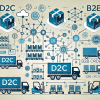Global food and beverage manufacturers increased their commitment to supply chain improvements when the pandemic highlighted existing issues. The pandemic shined a spotlight on problem areas, from environmental changes to trade tensions to fluctuating regulations. Strengthening supply chains and increasing transparency is the solution.
Supply chain visibility and flexibility issues can cause significant problems down the line when businesses don’t address them. Urgent improvements in supply chain visibility are required. Food industry professionals also need to handle the end-to-end supply chain complexity.
Understanding Traceability
In the past, traceability was essential for regulatory compliance in the food industry. As innovation and data collection have grown, traceability is increasingly crucial for food safety and operational efficiency.
Traceability examines the functions that track the flow of foods during production, processing, and distribution. With traceability, you can trace the path of any product at any food chain location within the supply chain.
Since traceability helps maintain food safety, you need integrated systems to ensure day-to-day operations and contamination and safety issues are handled correctly. Fiddle makes it easy to do food traceability right with lot tracking and batch records.
Traceability Components
Traceability is all about tracking and tracing. Tracing centers on a product’s routes across the food chain and provides data about its origin and movements forward.
Tracking pinpoints a certain product’s destination and follows its path from manufacturing to the final point of sale or consumption. Both tracking and tracing can follow a single item or a batch.
Relevance to Food Safety
The global aspect of the food supply chain grows ever-more complex. As a result, traceability is more important than ever. Traceability allows you to pinpoint the source of food contamination or safety issues and understand the scope.
Thanks to traceability’s visibility and transparency, your company is better prepared for an issue. Traceability allows for a prompt response when an incident occurs and helps food processors deal with the problem quickly. That can help prevent future problems and restore customer confidence faster.
Food Traceability System Requirements
Across producers, suppliers, and distribution, programs need to standardize their data processing so that anyone can jump in to diagnose a problem and begin recovery throughout the food chain. (is that where lot tracking and batch records come into play?)
Traceability programs must be verifiable, results-driven, fair, cost-effective, and applied every time in every situation to work effectively.
Traceability Improves Visibility
Because traceability allows you to see where products are, who has worked on them, and how long until they’re finished, it increases your product’s life visibility in the supply chain.
It can also help with authentication because it allows you to identify products through records with data like origin certificates and purchase orders.
When traceability focuses on tracking the receipt and intake of raw materials and manufacturing processes, you can use it for internal record keeping. When it focuses on distribution and final destinations, it allows you to track and trace your products externally.
Compliance Gains
You can take it to the next level with an automation control system that acquires data from each sector. These total-package programs can provide feedback and look at the central manufacturing execution system (MES) and manufacturing operations management (MOM).
The MES must process data like timestamps, suppliers, and operators. Then, a traceability program can convert this information into production data for the plant manager to assess.
The MOM system works with the operators to ensure tasks are performed correctly. To provide forward and backward traceability, you can collect material lots, quantities, test results, and process parameters.
Embracing Traceability Technologies
Technology like Enterprise Resource Planning (ERP) software can allow companies to use the end-to-end visibility of operational processes to prevent issues. They provide a complete product history from ingredients used to finished goods that you can download and consult. It can even work with multi-site, multi-company, and multi-legislative supply chains.
The data can display:
- Who supplied and validated the raw materials
- Which steps went into the processes
- Who handled and signed off on the end product
- Who shipped and delivered the end product
- Who on the customer side validated the end product
By providing access to data across several streams, you can keep track of business opportunities and analyze the supply chain successes and areas for improvement.
It can include:
- Quality control
- Operations and scheduling
- Compliance
- Customizing quality and sustainability initiatives based on the actual requirements of individual markets
Enhanced Customer Service
Product safety is more important than ever, and the rules are stringent. In a product recall, traceability can protect the consumer and your reputation. Allowing consumer doubts to stew could have a lasting effect on your brand value.
You can show retailers you’re a viable, trustworthy supplier through traceability. Digital traceability also allows you to showcase products that come from environmentally sustainable and ethical sources. Investing in traceability is required from a regulatory perspective. It can also positively impact the long-term brand value of your business.
Think of UK-based organic baby food maker Ella’s Kitchen. Thanks to their “full traceability, field to farm, factory to family” credentials, they have become a widely trusted food brand, and their profits reflect that. Direct-to-consumer (D2C) channels can take this to a whole other level.
Digital Transformation
Traceability has to be accurate and offer real-time information to be effective. Harnessing important data and sharing it across your business makes traceability a powerful tool for operations management and compliance.
You want to compete in an increasingly digital environment. Embracing the newest developments in cloud technology allows you to do just that by putting you in an excellent position to meet quality, documentation, and traceability requirements.
Plus, with digitally-backed end-to-end visibility, you can optimize your supply chain to run smoothly and improve your customer experience. Traceability can allow you to drive your company toward a better customer experience, enhanced quality control, and operations that run smoothly from end to end.
If all of this talk of traceability still has your head swimming, we have your back! Our modern operations management software will help you with traceability across your manufacturing and sourcing.
That means you don’t have to worry about using broken spreadsheets or anything slipping through the cracks! Start a Free 14-Day Trial (no credit card required) or schedule a personalized demo to see how it all works!










